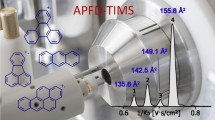Abstract
The Penning trap mass spectrometer SMILETRAP has been considerably improved during the last two years. The helium pressure has been carefully stabilized and is now independent of irregular air pressure. The temperature of the hyperboloidal precision trap is stabilized to ±0.03°C. Remaining temperature instabilities are compensated by changes in the current of a warm coil surrounding the precision trap. The frequency synthesizer is now locked to GPS. This means that it is much easier to accurately measure resonances during several days. The improvements have demonstrated that in mass doublet measurements with an excitation time of 1 s it is possible to determine the mass of ions with q/A=1/2 at an uncertainty to a few times of 0.1 ppb, using selected rather than cooled ions. In routine measurements lasting for one day it is possible to reach a mass uncertainty of 1 ppb. The masses of the following particles and atoms have been measured with uncertainties in the region 0.3–2 ppb: p, 3H, 3He, 4He, 22Ne, 28Si, 36Ar, 76Ge, 76Se, 86Kr and 133Cs. It has also been shown that though we are using a warm bore the trap pressure is sufficiently low to prevent electron capture from the rest gas for excitation times of 3 s and for ion charges as high as 50+.
Similar content being viewed by others
References
Carlberg, C., Hyp. Interact. 114 (1998), 177.
Carlberg, C. et al., Physica Scripta T 59 (1995), 196.
Gräff, G., Kalinowsky, H. and Traut, J., Z. Phys. A 297 (1980), 35.
Bollen, G. et al., Nucl. Instr. Meth. Phys. Res. A 368 (1996), 675.
Beck, B. R., Steiger, J., Weinberg, G., Church, D. A., McDonald, J. and Schneider, D., Phys. Rev. Lett. 77 (1996), 1735.
Douysset, G. et al., Phys. Rev. Lett. 86 (2001), 4259.
Audi, G. and Wapstra, A. H., Nucl. Phys. A 565 (1993), 1.
van Dyck, Jr., R. S., Farnham, D. L. and Schwinberg, P. B., Physica Scripta T 59 (1995), 134.
Fritioff, T. et al., submitted to Europhysics J., rapid communications.
Bradley, M. et al., Phys. Rev. Lett. 83 (1999), 4510; Carlberg,C., Fritioff, T. and Bergström, I.,Phys. Rev. Lett. 83 (1999), 4506.
DiFilippo, F. et al., Physica Scripta T 59 (1995), 144.
Ellis, R. J. et al., Nucl. Phys. A 435 (1985), 34.
Hykaway, J. G. et al., Phys. Rev. Lett. 67 (1991), 1708.
Audi, G., Wapstra, A. H. and Didieu, M., Nucl. Phys. A 565 (1993), 193.
Rodrigues, G. C. et al., accepted by Phys. Rev. A.
Bergström, I. et al., to be submitted to NIM.
Author information
Authors and Affiliations
Rights and permissions
About this article
Cite this article
Fritioff, T., Carlberg, C., Douysset, G. et al. Recent Progress with the SMILETRAP Penning Mass Spectrometer. Hyperfine Interactions 132, 229–242 (2001). https://doi.org/10.1023/A:1011991032748
Issue Date:
DOI: https://doi.org/10.1023/A:1011991032748




